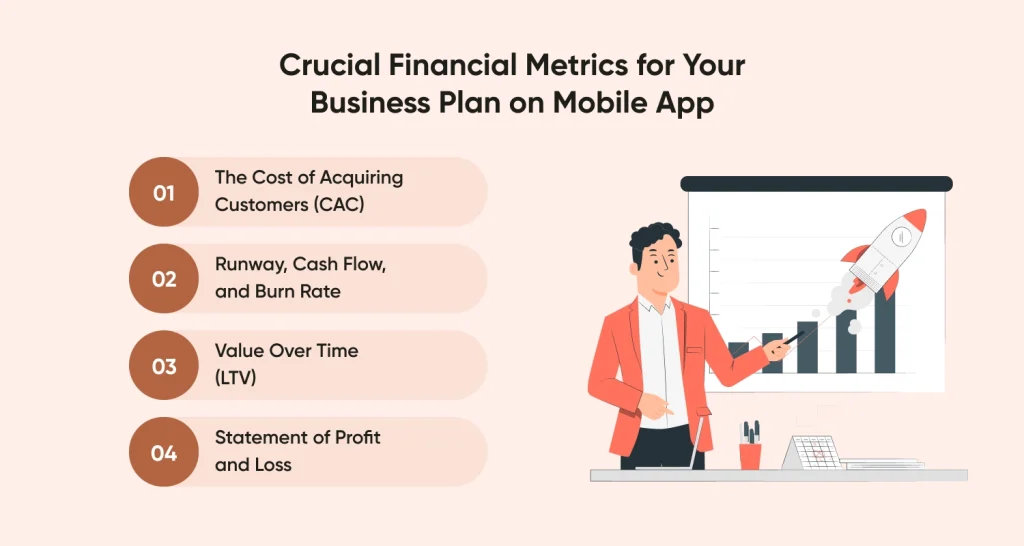There are many factors to consider when setting up a mobile app for a startup, including people, money, core concept, workload, and product implementation. To create a clear roadmap for your project or a business plan for developing mobile apps, you must correctly put all the important pieces of this puzzle together.
Hire mobile app developers and study app business models from development companies to create app business plans. A comprehensive approach to writing a business plan may be found here. We’ve also included our template so that investors and other stakeholders may comprehend your startup idea equally and, most crucially. Thus, let’s learn more about app planning if you still need to learn how to accomplish it or where to begin.
Why Is A Business Plan For A Mobile App Important?
According to statistics, paid downloads and in-app advertising from mobile apps are expected to bring in over 935 billion dollars in income by 2023.
Business plans are necessary for both startups and established companies, and their content will be determined by their main objective.
Startup entrepreneurs typically utilize a business model canvas, which is a more adaptable version of a standard business plan, to entice investors. It can easily adjust to the iterative process of tech startup development while still giving important project details.
- Enticing Capital
As you might expect, the primary goal of business plans written by mobile app businesses is to draw in more and more capital for the purpose of outsourcing app development. This is intended to draw in investors and possibly even startup co-founders; ultimately, it’s up to you, but occasionally you’ll need their backing. A strong business plan will enable you to communicate your vision clearly and concisely.
- Best Perspective
When making major decisions, it’s easy to neglect or omit some crucial details that could subsequently create or destroy the basis of your company. It is easier for you to recall those important details, though, if your blueprint has a series of points that serve as a reminder of them. A business strategy for on-demand app development is all you need to know.
- Mitigating the Risks
Creating a business strategy entails mapping out the entire course of your venture, which can offer valuable insights into the numerous unforeseen and likely hazards.
How to Create a Business Plan for an App?
Developing a dependable and stable mobile application for entrepreneurs, or business plan for startups, or nonprofits is your goal. In this scenario, a business strategy will assist you in laying the foundation for a successful enterprise.
As a result, you must forecast the cost of development and commissioning as well as the timeline for your project’s return on investment when creating a mobile app business plan for startups. You won’t be able to see your app’s feasibility clearly unless you take this action.
Offering the highest level of openness at every stage is one of the key components of a strong mobile app startup business strategy. Let’s discuss the essential components of a mobile app for a business plan that can help your company succeed in the most effective way possible.
Executive Summary
Somewhere has to be your starting point! As a result, you should give extra attention to the synopsis of your comprehensive mobile application business plan, as this will be what potential investors see first.
This section is best when it conveys more information in fewer words, doesn’t explain how the product works, and so on. Rather, concentrate more on the market environment and the intended audience, and make sure to carry out the actions listed below:
- Concentrate on the issues at hand
- The current needs and demands of the users
- Issues consumers have with comparable items that you offer; the reasons these solutions fall short of their expectations; what is it that you can offer more effectively?
- State your solution wisely
When outlining the answer to a problem, try not to go off course. That is, don’t discuss the features and operation of your app; instead, concentrate on the issues at hand and how your app solves them.
Description of the Business
This section serves as an introduction to your business, starting with corporate details and concluding with the idea for your mobile app. This section of your startup business plan will outline for investors your company’s mission, vision for your products, and core values-along with the critical success elements that will propel your venture forward.
For investors, this knowledge is essential. For instance, Y Combinator, a startup accelerator focused on technology, views raising capital as comparatively easier than working on ideas, which is ultimately what makes a firm successful. Y-Combinator-like companies typically require the completion of a comprehensive business plan before presenting freshly formed initiatives to potential investors.
Company Overview
A description of a corporation is precisely what it sounds like. Having said that, don’t hesitate to provide specifics on different aspects of your company.
In addition to a brief history and an outline of your company’s goals and target audience, this description should include information on your company’s suppliers, legal structure, and financial highlights. What are you selling, in brief? Provide a thorough explanation of the good or service you offer, emphasizing the advantages for the client.
Once more, use descriptive language. Include information about patents, research and development plans, copyrights, and the product’s performance in the marketplace. At this point, you ought to begin formulating conclusions based on market study, which should include information like a breakdown of your industry, a sketch of the target client categories, past and present market estimates, and a query of your rivals. Both qualitative and quantitative data should support all of this.

Strategic Operation
Declaring your plan about your day-to-day operations gives investors the idea that you are aware of and prepared, which is always beneficial. This covers your customer relations approach as well.
You need to lay out exactly how you’re going to manage customer service and uphold quality control. It also covers the execution and management of the mobile app development services. Additional topics to discuss in this area are:
You can talk about things like how your users will act when they first discover and use your app, for example, and how they will act during the entire experience. This lists every piece of information on the workers. It involves several issues, including when and how to hire staff, how to deduct expenses for salaries, how to establish organizational structure, and much more.
Finance Management
You must be crystal clear about the type of funding you require to proceed before you can properly structure this section of your business plan. Additionally, you must be as explicit as you can be to ensure that a potential investor understands the type of cash you require.
A three- to five-year prediction of all the major expected indicators, such as profit and loss, cash flow, balance sheets, start tables, unit economics calculation, and your app’s anticipated revenues and costs, is typically included in the financial model. To ascertain the true cost and optimal allocation of assets, your financial record must have the following elements, each with a detailed explanation.
Funds
This is the point where you will request money and disclose any relevant details. In this section, respond to these inquiries.
- What is the amount of money you need?
- What proportion of stock would you like to give back in exchange?
- Will this be preferred stock or a convertible note?
- How long will this funding last before you move to the next round of application development or the process?
Monetization Strategy
You should include this in your business plan for your mobile app. You may show investors and other stakeholders that your project will be successful and generate a positive unit economics return on investment by illustrating your monetization approach. Additionally, it will reassure you that your startup will break even.
The following are the most popular methods of app monetization:
- Promoting
- Charging for the application: If your business plan calls for a paid application, you must persuade the user of the necessity and benefit of paying for it.
- In-app purchases: This popular mobile app business model is seen in both iOS and Android apps.
- Subscriptions (this monetization strategy is highly common and operates until the user chooses to stop using it; most subscription apps offer a free trial period)
4 Crucial Financial Metrics for Your Business Plan on Mobile Apps

Metrics are necessary to ensure that your app monetization strategy is effective once you’ve made your decision. These metrics are important to consider when you intend to verify or monetize your mobile app.
These metrics will be speculative before you create your application. They can still assist you in understanding the long-term performance of your software and company, though.
1. The Cost of Acquiring Customers (CAC)
This measure would be known as cost per app install (CPI) in the mobile setting. Proceeding further can help you determine the cost per activation (CPA).
You will need to rely on industry benchmarks because you do not now have access to this kind of information. You can get monthly cost per thousand (CPM) information from companies such as Fiksu.
2. Value Over Time (LTV)
Ideally, you should be aware of the average revenue a single user may provide for you.
A low lifetime value (LTV) will raise warning flags, and you’ll struggle to break even if your acquisition expenditures are excessive.
3. Runway, Cash Flow, and Burn Rate
In essence, your burn rate is the speed at which a startup “burns” its available funds. Monthly increments can be used to measure this. This can also be thought of as negative cash flow. Fees, hosting costs, and other variable and fixed overheads all cost money. You will want to minimize cash flow, just like in any successful firm.
Runway is the amount of time you have left before your company’s expenses run out. This formula can be used to determine runway:
Runway = (Total funds) / (Burn Rate)
Of course, the effectiveness of your monetization plan will dictate your cash flow.
4. Statement of Profit and Loss
Lastly, you want to protect your gains and losses over a full year. The assets and liabilities you may accumulate are listed in this section.
It is reasonable to consider three scenarios when assessing your potential earnings: the best-case scenario, the worst-case scenario, and, well, practical circumstances.
You can determine where you might wish to make expense reductions by examining these three distinct outcomes. In theory, you should avoid going bankrupt in your first few months of operation. In the worst-case scenario, if you can recoup your first year’s spending through stimulation, your software has a lot of potential in the market.
Conclusion
It’s not simple to write a business strategy for a startup mobile app. Writing the first page of a business plan for a mobile app idea is typically the most difficult task. In this case, a lot of people search for and download a free copy of the business plan of another company. They erroneously think that adopting the business plan of another person will enable them to succeed. But it most definitely won’t!
A business plan is not a copy of itself. It ought to be unique, showcasing your zeal and love for realizing your concept. A strong business plan should show that your venture is both profitable and feasible. The investment opportunity increases with increasing viability.
A cross-platform app development company – CMARIX is available to assist you if you need assistance creating a comprehensive business plan to draw in investors and launch your app with success.
Frequently Asked Questions
How to Make a Mobile App for Business?
Form a team dedicated to development. App builders are among the web tools and software programs that have made app development easier.
Carry out research with competition.
Describe the main aspects.
Make prototypes.
Make a great app security plan.
Start writing code.
Collect and apply user feedback.
Open the application store and launch.
Is an App a Profitable Business?
You need to have something special to offer to make a successful app. You need to provide a quality product if you want people to purchase it. You won’t get any return on investment for your app or business if you are just selling what everyone else is selling.
What Are the Necessary Features to Be Included in Mobile App Development?
The most important features to be included in an app are:
User Interface and experience
Easy Navigation Security
Privacy of Data Customisation
Basic Interface: Offline Features
Evaluations, Comments, and Client Assistance
Push Notifications
Multiple Device Syncing







